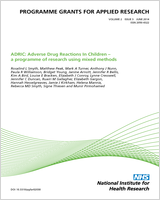Included under terms of UK Non-commercial Government License.
NCBI Bookshelf. A service of the National Library of Medicine, National Institutes of Health.
Gunnell D, Hawton K, Bennewith O, et al. A multicentre programme of clinical and public health research in support of the National Suicide Prevention Strategy for England. Southampton (UK): NIHR Journals Library; 2013 Oct. (Programme Grants for Applied Research, No. 1.1.)

A multicentre programme of clinical and public health research in support of the National Suicide Prevention Strategy for England.
Show detailsThe following is an explanation of the method of Wagner et al.,80 applied to our particular analysis. Segmented regression analysis is a method of estimating changes in levels and trends in an outcome (deaths, in our case) associated with an intervention (the legislation in the third quarter of 1998 to reduce pack size of paracetamol). The time-series regression equation for this model is:
where Ŷt is the outcome (mean number of deaths per quarter); time indicates the number of quarters from the start of the series (1–68); intervention is a dummy variable taking the values 0 in the pre-intervention segment and 1 in the post-intervention segment; time_after_intervention is 0 in the pre-intervention segment and counts the quarters in the post-intervention segment at time t (1–45); the coefficient β0 estimates the base level of the outcome (number of deaths) at the beginning of the series; β1 estimates the base trend, that is, the change in outcome per quarter in the pre-intervention segment; β2 estimates the change in level of deaths in the post-intervention segment; β3 estimates the change in trend in deaths in the post-intervention segment; and et estimates the error.
Absolute effect of the intervention
The model was used to estimate the absolute effect of the intervention in two ways, both of which we used:
- (a) First, we calculated the difference between the estimated outcome at a certain time after the intervention and the outcome at that time if the intervention had not taken place. For example, to estimate the effect of the intervention at the mid-point of the post-intervention period (when time = 46 and time_after_intervention = 23), we have:
Thus, the absolute effect of the intervention is:
- (b) Second, when there is an increasing trend in the pre-intervention period, a more conservative estimate of the absolute effect of the intervention may be calculated. Here the outcome without the intervention was taken at the earlier time (not assuming any increase in the post-intervention period). Thus, we have:
and the outcome with the intervention remains unchanged:
Thus, the conservative estimate of absolute effect of the intervention was:
Coefficients and errors from full models including all terms in Equation 1 are given in Table 46. Non-significant terms were included as there may be correlation between slope and level terms, which should be accounted for.
TABLE 46
Interrupted time-series segmented regression analysis of deaths from paracetamol poisoning, other drug poisoning and all causes in England and Wales for individuals aged ≥ 10 years, 1993–2009
- Interrupted time-series segmented regression analysis - A multicentre programme ...Interrupted time-series segmented regression analysis - A multicentre programme of clinical and public health research in support of the National Suicide Prevention Strategy for England
Your browsing activity is empty.
Activity recording is turned off.
See more...